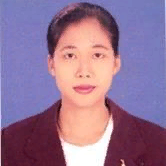
Phyu Phyu Khaing
Work place: University of Computer Studies, Mandalay, Myanmar
E-mail: phyuphyukhaing@ucsm.edu.mm
Website:
Research Interests: Data Structures and Algorithms, Image Processing, Image Manipulation, Image Compression, Computer Vision, Computer systems and computational processes
Biography
Phyu Phyu Khaing is an Assistant Lecturer in the Myanmar Institute of Information Technology, Mandalay, Myanmar. She received her B.C.Sc. degree in 2007, B.C.Sc. (Hons.) in 2008 and M.C.Sc. degree in 2010 from Computer University (Monywa), Myanmar. She is currently working toward the Ph.D. degree in University of Computer Studies, Mandalay, Myanmar. Her research interests include computer vision, digital image processing, and Deep Learning.
Author Articles
Study for License Plate Detection
By Mie Mie Aung Phyu Phyu Khaing Myint San
DOI: https://doi.org/10.5815/ijigsp.2019.12.05, Pub. Date: 8 Dec. 2019
License Plate Detection (LPD) system is the application of computer vision and image processing technology. LPD system is the first and main step of License Plate Recognition (LPR) system. So, it performs as the main driver of the LPR system. License plate detection step is always performed in front of the license plate recognition step. LPD system takes the vehicle images as input, follows with the general steps: such as reprocessing, localization, region extraction, and region detection, and the detected image are the output of the system. There are many algorithms for LPD while detecting a license plate in different conditions is still a complex task. For the LPD system, morphological operation and deep learning model are mostly used. This paper presents the critical study of the license plate detection system and also examines the implementation of new technologies of the license plate detection system.
[...] Read more.Fruit Recognition Using Color and Morphological Features Fusion
By Myint San Mie Mie Aung Phyu Phyu Khaing
DOI: https://doi.org/10.5815/ijigsp.2019.10.02, Pub. Date: 8 Oct. 2019
It is still difficult to recognize the kind of fruit which are of different colors, shapes, and textures. This paper proposes a features fusion method to recognize five different classes of fruits that are the images from the fruit360 dataset. We are processed with four stages: pre-processing, boundary extraction, feature extractions, and classification. Pre-processing is performed to remove the noise by using the median filter, and boundary extraction are operated with the morphological operation. In feature extraction, we have extracted two types of features: color, and morphological features of the image. Color features are extracted from the RGB color channel, and morphological features are extracted from the image that detected the boundary of fruit by using morphological operations. These two types of features are combined in a single feature descriptor. These features are passed to five different classifiers: Naïve Bayes (NB), Logistic Regression (LR), Support Vector Machine (SVM), Decision Tree (DT), K-Nearest Neighbor (KNN), and Random Forest (RF). In the study, the accuracy that classified with Random Forest (RF) classifier for the proposed feature fusion method is better than the other classifiers, such as Naïve Bayes (NB), Logistic Regression (LR), Support Vector Machine (SVM), Decision Tree (DT), K-Nearest Neighbor (KNN).
[...] Read more.Attention-Based Deep Learning Model for Image Captioning: A Comparative Study
DOI: https://doi.org/10.5815/ijigsp.2019.06.01, Pub. Date: 8 Jun. 2019
Image captioning is the description generated from images. Generating the caption of an image is one part of computer vision or image processing from artificial intelligence (AI). Image captioning is also the bridge between the vision process and natural language process. In image captioning, there are two parts: sentence based generation and single word generation. Deep Learning has become the main driver of many new applications and is also much more accessible in terms of the learning curve. Image captioning by applying deep learning model can enhance the description accuracy. Attention mechanisms are the upward trend in the model of deep learning for image caption generation. This paper proposes the comparative study for attention-based deep learning model for image captioning. This presents the basic analyzing techniques for performance, advantages, and weakness. This also discusses the datasets for image captioning and the evaluation metrics to test the accuracy.
[...] Read more.Other Articles
Subscribe to receive issue release notifications and newsletters from MECS Press journals